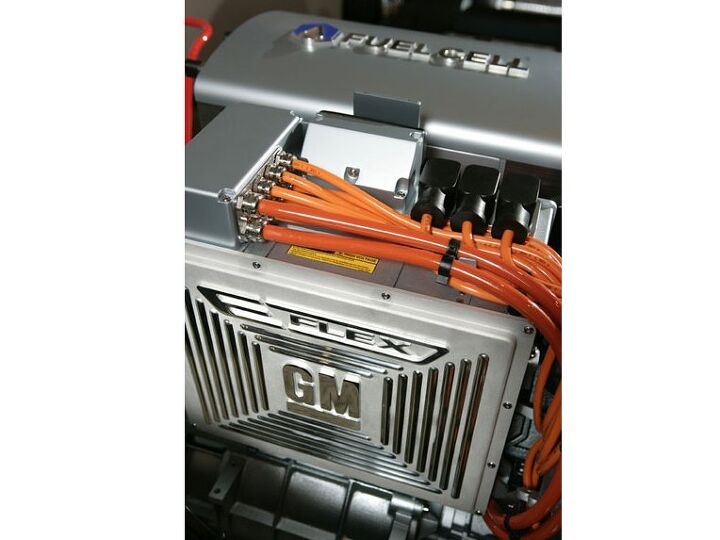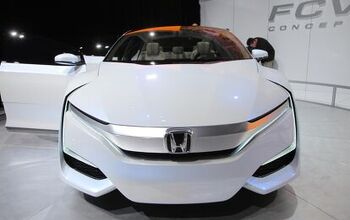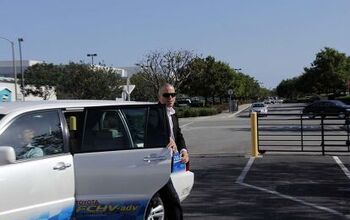Department Of Energy: Hydrogen Still The Future
Same as it ever was. Green Car Congress covers a DOE report (pdf) to the U.S. Congress on its $1.2b Hydrogen fuel cell development caucus, and the conclusion is clear: keep waiting. The DOE had harbored a shockingly naive hope that OEMs would be able to field 100k fuel cell vehicles by 2010, but the new report seems pretty clear on the chances of that happening. According to the report, “a 2008 independent study estimated that the high-volume manufacturing cost of automotive fuel cell systems (using current technology and assuming 500,000 units per year) would be $73/kW, which equates to almost $6000 for an 80-kW system. This current technology would be more than twice as expensive as internal combustion engine systems. And, based on the highest demonstrated durability to date, fuel cell systems would have a lifespan of approximately 1900 hours, which equates to about 57,000 miles and is still substantially lower than today’s estimated vehicular lifespan of 150,000 miles.” Sound familiar?
But, don’t worry. That $1.2b went to good use, “improving understanding of size range and spatial distribution of nano-scale water channels in Nafion membranes; . . . Developing and demonstrating a novel cryo-compressed tank concept” for which “system cost remains an issue”; and countless other “breakthroughs” which somehow don’t make hydrogen any less of a pipedream than it was two decades ago. The best part? “While fuel cell technology development is currently on track to meet the Program’s 2015 technology-readiness targets, it is too early to determine whether industry can achieve the 2020 vehicle deployment goal of 2.5 million hydrogen-fueled vehicles identified in [Energy Policy Act] section 811(a). However, analyses conducted by Oak Ridge National Laboratory indicate that such a deployment scenario would not be achieved without substantial supportive policies and incentives.” Fantastic. But hey, the DOE wants your feedback on their hydrogen dreams. Check out their request for information (RFI) here.
More by Edward Niedermeyer
Latest Car Reviews
Read moreLatest Product Reviews
Read moreRecent Comments
- Doughboy I’ve seen car bras before, but never car beards. ZZ Top would be proud.
- Bkojote Allright, actual person who knows trucks here, the article gets it a bit wrong.First off, the Maverick is not at all comparable to a Tacoma just because they're both Hybrids. Or lemme be blunt, the butch-est non-hybrid Maverick Tremor is suitable for 2/10 difficulty trails, a Trailhunter is for about 5/10 or maybe 6/10, just about the upper end of any stock vehicle you're buying from the factory. Aside from a Sasquatch Bronco or Rubicon Jeep Wrangler you're looking at something you're towing back if you want more capability (or perhaps something you /wish/ you were towing back.)Now, where the real world difference should play out is on the trail, where a lot of low speed crawling usually saps efficiency, especially when loaded to the gills. Real world MPG from a 4Runner is about 12-13mpg, So if this loaded-with-overlander-catalog Trailhunter is still pulling in the 20's - or even 18-19, that's a massive improvement.
- Lou_BC "That’s expensive for a midsize pickup" All of the "offroad" midsize trucks fall in that 65k USD range. The ZR2 is probably the cheapest ( without Bison option).
- Lou_BC There are a few in my town. They come out on sunny days. I'd rather spend $29k on a square body Chevy
- Lou_BC I had a 2010 Ford F150 and 2010 Toyota Sienna. The F150 went through 3 sets of brakes and Sienna 2 sets. Similar mileage and 10 year span.4 sets tires on F150. Truck needed a set of rear shocks and front axle seals. The solenoid in the T-case was replaced under warranty. I replaced a "blend door motor" on heater. Sienna needed a water pump and heater blower both on warranty. One TSB then recall on spare tire cable. Has a limp mode due to an engine sensor failure. At 11 years old I had to replace clutch pack in rear diff F150. My ZR2 diesel at 55,000 km. Needs new tires. Duratrac's worn and chewed up. Needed front end alignment (1st time ever on any truck I've owned).Rear brakes worn out. Left pads were to metal. Chevy rear brakes don't like offroad. Weird "inside out" dents in a few spots rear fenders. Typically GM can't really build an offroad truck issue. They won't warranty. Has fender-well liners. Tore off one rear shock protector. Was cheaper to order from GM warehouse through parts supplier than through Chevy dealer. Lots of squeaks and rattles. Infotainment has crashed a few times. Seat heater modual was on recall. One of those post sale retrofit.Local dealer is horrific. If my son can't service or repair it, I'll drive 120 km to the next town. 1st and last Chevy. Love the drivetrain and suspension. Fit and finish mediocre. Dealer sucks.


































Comments
Join the conversation
Hydrogen, even liquid hydrogen, is so light that any given volume of it carries very little energy. One liter of liquid hydrogen contains 71 grams of hydrogen. One liter of gasoline contains 118 grams of hydrogen, and one liter of diesel, 130 grams. Of course liquid hydrogen costs lots of energy to make, is difficult to store (it will leak out of any container in a matter of days), and is 423 degrees F below zero, so be very careful when handling it. Compressed hydrogen is less dense than liquid, and kaboom.
Seems as if the DOE wants to curtail their spending on the hydrogen economy. Even Ballard Power in Canada saw fit to exit the fuelcells-for-cars business some time ago. The announcement came as they spun off their test cell business. Confidence couldn't have been high at the time as it needed the key researchers to form the management team of this new entity. Later on this team secured all the related equipment in a buyout package. At least that was my understanding. Though hydrogen may be the the first to go here, I can see when American Leyland eventually goes under that the DOE will have even more reason to terminate other related powertrain programs it has scattered among the various National Labs. It almost seems that research in North America is wholly in the public sector, with the costs socialised wherever possible and when applicable the profits privatised. It makes me feel that the government should form an engineering corp just like we have the police, teachers, mail delivery and other public services. That it is a given that you become a government worker as an entitlement when you leave college/university and only in rare cases do you move out into the employ of capitalised companies. T2